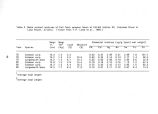| OCR Text |
Show Alternative C: Develop baseline information on water resources in prospective leasing areas ( preferred alternative) Under this alternative, data on hydrology and water quality in prospective lease areas would be obtained as research funding becomes available. Identification of aquifers and recharge areas, the origin of surface flows, and baseline water quality are among the subjects requiring investigation. I ILL. 3. Recommended course of action. Alternatives B and C are recommended because Alternative A would prolong the lack of park- specific standards and background data. This in turn could result in inadequate protection of park resources from the effects of oil and gas operations. III. M. Tar Sand Operations III. M. 1. Statement of the problem. Energy firms with extensive oil and gas lease holdings in Glen Canyon National Recreation Area have filed a Plan of Operations with the Bureau of Land Management for converting their leases to combined hydrocarbon leases, which would allow development of tar sands to produce crude oil. The leases are within the Tar Sand Triangle, the largest of eleven " Special Tar Sand Areas" in Utah where the federal minerals are available for competitive lease. About half of the 66,000- acre development proposal would be within the NRA in the Orange Cliffs region bordering Canyonlands National Park. Steam injection is proposed to soften the tar and allow its extraction through conventional pumps. An estimated 1,680 acre- feet of water per year from the Dirty Devil River would be consumed. Other Tar Sand Triangle operations for lands bordering the NRA have also been proposed, affecting 50,000 acres of public lands between the Dirty Devil River and Orange Cliffs. Steam injection and in- situ combustion methods are proposed in this area. Another proposal for development could affect the Circle Cliffs Special Tar Sand Area adjacent to Glen Canyon NRA and Capitol Reef National Park. This operation would use in- situ combustion techniques to extract oil from an area encompassing 57,000 acres of BLM- managed public land located in the angle between the two parks. All of the area is within the drainage of the Escalante River, which empties into Lake Powell and is a major water resource of the NRA. White Canyon Special Tar Sand Area, east of the Colorado River, is within five miles of the NRA boundary at Short Canyon. This deposit is smaller than the others and has received no development proposals. It is available for future competitive lease; if development were to occur, Dark Canyon and White Canyon could be affected. 57 |








































































































